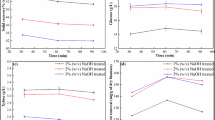Abstract
The utilization of bioethanol is being focused on as a fuel alternative to oil and or natural gas. Bioethanol production from cellulosic plant residues is one of the solutions proposed for the problems caused by usage of food crops that are also vital for human consumption, such as sugar cane and corn, as a source of bioethanol. However, to utilize these new sources for bioethanol production, conditions for saccharification in each different material have not been optimized. In this study, we reported some optimum conditions for the saccharification of Korean lawn grass (KL) and bent grass (BG) using acremonium cellulase and endoglucanase as saccharifying enzymes for ethanol fermentation. With respect to saccharification of KL and BG, 0.19 and 0.18 g of d-glucose per g-substrate at maximum were produced, respectively. Comminution with a ball mill was found to be effective in the saccharification of KL, while ball-milled BG showed no significant improvement in saccharification. Being incorporated with 99 % of d-glucose consumption, saccharified KL was incubated for 3 days with Saccharomyces cerevisiae and Zymomonas mobilis, respectively, and each mixture fermented to ethanol yielding approximately 100 % of theoretical values from d-glucose consumption, respectively.






Similar content being viewed by others
References
Koreishi M, Imanaka H, Imamura K, Kariyama M, Nakanishi K (2009) Efficient ethanol production from wheat bran by enzymatic saccharification using commercially available enzyme products and fermentation using baker’s yeast. Seibutsu-kogaku 87(5):216–223
Kai T, Tanimura T, Nozaki N, Suiko M, Ogawa K (2010) Bioconversion of soft cellulosic resources into sugar and ethanol. Seibutsu-kogaku 88(2):66–72
Yamashita Y, Sasaki C, Nakamura Y (2010) Effective enzyme saccharification and ethanol production from Japanese cedar using various pretreatment methods. J Biosci Bioeng 110(1):79–86
Buaban B, Inoue H, Yano S, Tanapongpipat S, Ruanglek V, Champreda V, Pichyangkura R, Rengpipat S, Eurwilaichitr L (2010) Bioethanol production from ball milled bagasse using an on-site produced fungal enzyme cocktail and xylose-fermenting Pichia stipitis. J Biosci Bioeng 110:18–25
Kahar P, Taku K, Tanaka S (2010) Enzymatic digestion of corncobs pretreated with low strength of sulfuric acid for bioethanol production. J Biosci Bioeng 110:453–458
Li Y, Park J, Shiroma R, Tokuyama K (2011) Bioethanol production from rice straw by a sequential use of Saccharomyces cerevisiae and Pichia stipitis with heat inactivation of Saccharomyces cerevisiae cells prior to xylose fermentation. J Biosci Bioeng 110:682–686
Yanagisawa M, Ojima T, Nakasaki K (2011) Bioethanol from sea lettuce with use of crude enzymes derived from waste. J Matr Cycles Waste Manag 13 (in press)
Takamizawa K, Anderson W, Singh HP (2010) Ethanol from lignocellulosic crops. In: Singh BP (ed) Industrial crops and uses. CABI, Oxfordshire, pp 104–139
Bradford MM (1976) A rapid and sensitive method for the quantitation of microgram quantities of protein utilizing the principle of protein–dye binding. Anal Biochem 72:248–254
Wise LE, Murphy M, D’Addieco AA (1946) Chlorite holocellulose, its fractionation and bearing on summative wood analysis and on studies on the hemicelluloses. Paper Trade J 122(2):35
Miller GL (1959) Use of dinitrosalicylic reagent for determination of reducing sugars. Anal Chem 31:426–428
Bailey MJ, Biely P, Poutanen K (1992) Interlaboratory testing of methods for assay of xylanase activity. J Biotechnol 23:257–270
Rahman AKMS, Sugitani N, Hatsu M, Takamizawa K (2003) A role of xylanase, α-l-arabinofuranosidase, and xylosidase in xylan degradation. Can J Microbiol 49:58–64
Teramoto Y, Tanaka N, Lee SH, Endo T (2007) Pretreatment of Eucalyptus wood chips for enzymatic saccharification using combined sulfuric acid-free ethanol cooking and ball milling. Biotechnol Bioeng 99:75–85
Yoshida M, Liu Y, Uchida S, Kawarada K, Ukagami Y, Ichinose H, Kaneko S, Fukuda K (2008) Effects of cellulose crystallinity, hemicellulose, and lignin on the enzymatic hydrolysis of Miscanthus sinensis to monosaccharides. Biosci Biotechnol Biochem 72:805–810
Byron CH, Chu HL (2007) Genetic improvement of Saccharomyces cerevisiae for xylose fermentation. Biotechnol Adv 25:425–441
Kondo K, Ueda M (2004) Yeast cell-surface display-applications of molecular display. Appl Microbiol Biotechnol 64:28–40
Author information
Authors and Affiliations
Corresponding author
Rights and permissions
About this article
Cite this article
Takamizawa, K., Ishikawa, E., Nakamura, K. et al. Bioethanol production from enzymatically saccharified lawn clippings from a golf course. J Mater Cycles Waste Manag 15, 16–24 (2013). https://doi.org/10.1007/s10163-012-0078-5
Received:
Accepted:
Published:
Issue Date:
DOI: https://doi.org/10.1007/s10163-012-0078-5




